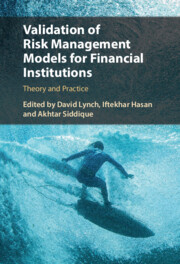Book contents
- Validation of Risk Management Models for Financial Institutions
- Validation of Risk Management Models for Financial Institutions
- Copyright page
- Contents
- Figures
- Tables
- Contributors
- Foreword
- Acknowledgments
- 1 Common Elements in Validation of Risk Models Used in Financial Institutions
- 2 Validating Bank Holding Companies’ Value-at-Risk Models for Market Risk
- 3 A Conditional Testing Approach for Value-at-Risk Model Performance Evaluation
- 4 Beyond Exceedance-Based Backtesting of Value-at-Risk Models: Methods for Backtesting the Entire Forecasting Distribution Using Probability Integral Transform
- 5 Evaluation of Value-at-Risk Models: An Empirical Likelihood Approach
- 6 Evaluating Banks’ Value-at-Risk Models during the COVID-19 Crisis
- 7 Performance Monitoring for Supervisory Stress-Testing Models
- 8 Counterparty Credit Risk
- 9 Validation of Retail Credit Risk Models
- 10 Issues in the Validation of Wholesale Credit Risk Models
- 11 Case Studies in Wholesale Risk Model Validation
- 12 Validation of Models Used by Banks to Estimate Their Allowance for Loan and Lease Losses
- 13 Operational Risk
- 14 Statistical Decisioning Tools for Model Risk Management
- 15 Validation of Risk Aggregation in Economic Capital Models
- 16 Model Validation of Interest Rate Risk (Banking Book) Models
- 17 Validation of Risk Management Models in Investment Management
- Index
- References
15 - Validation of Risk Aggregation in Economic Capital Models
Published online by Cambridge University Press: 02 March 2023
- Validation of Risk Management Models for Financial Institutions
- Validation of Risk Management Models for Financial Institutions
- Copyright page
- Contents
- Figures
- Tables
- Contributors
- Foreword
- Acknowledgments
- 1 Common Elements in Validation of Risk Models Used in Financial Institutions
- 2 Validating Bank Holding Companies’ Value-at-Risk Models for Market Risk
- 3 A Conditional Testing Approach for Value-at-Risk Model Performance Evaluation
- 4 Beyond Exceedance-Based Backtesting of Value-at-Risk Models: Methods for Backtesting the Entire Forecasting Distribution Using Probability Integral Transform
- 5 Evaluation of Value-at-Risk Models: An Empirical Likelihood Approach
- 6 Evaluating Banks’ Value-at-Risk Models during the COVID-19 Crisis
- 7 Performance Monitoring for Supervisory Stress-Testing Models
- 8 Counterparty Credit Risk
- 9 Validation of Retail Credit Risk Models
- 10 Issues in the Validation of Wholesale Credit Risk Models
- 11 Case Studies in Wholesale Risk Model Validation
- 12 Validation of Models Used by Banks to Estimate Their Allowance for Loan and Lease Losses
- 13 Operational Risk
- 14 Statistical Decisioning Tools for Model Risk Management
- 15 Validation of Risk Aggregation in Economic Capital Models
- 16 Model Validation of Interest Rate Risk (Banking Book) Models
- 17 Validation of Risk Management Models in Investment Management
- Index
- References
Summary
This chapter implements a coherent statistical framework for validation of economic capital models via copula methods using a unique dataset to aggregate credit, market, operational, and interest rate risks. This framework includes benchmarking with alternative copula models and backtesting with alternative penalty functions, in addition to stability and stress tests of economic capital estimates. The analysis is expanded to include the latest supervisory guidance on model validation (i.e. SR11-7) and Basel Accord changes (i.e., Basel III). Second, proprietary confidential loss data is used from major US banks for market risk and operational risk. Lastly, both analytic and visual goodness-of-fit tests for copula models are included. For the data used in this study, the T copula with 4 degree of freedom provides a good statistical fit, superior backtesting performance, reasonable model stability and sufficient sensitivity to stress. In addition, the results provide some support for regulators’ hesitation to recognize diversification benefits by demonstrating a wide range of diversification benefits across risk types under different dependence models.
Keywords
- Type
- Chapter
- Information
- Validation of Risk Management Models for Financial InstitutionsTheory and Practice, pp. 379 - 421Publisher: Cambridge University PressPrint publication year: 2023

